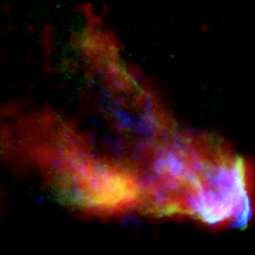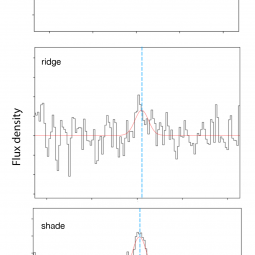By Archana Soam and Joan Schmelz
Paper:
Spatial Variation in Temperature and Density in the IC 63 PDR from H
2
Spectroscopy
Soam, Archana, et al., 2021/12, ApJ, 923, 107.
The high-energy radiation from new-born massive stars imposes physical and chemical changes on the surrounding clouds of gas and dust. These Photo-Dissociation Regions (PDRs), where far-ultraviolet radiation controls the gas heating and molecular dissociation, are astrophysically important sites in the evolution of the interstellar medium (ISM), including star formation and cloud destruction. While several models of PDR physics have been developed, a number of important detailed assumptions including the clumpiness, temperature structure, and reaction network remain uncertain. Progress requires additional observational constraints, especially those related to the micro-structure of the regions, so spatial resolution is vital.
Molecular hydrogen is readily detectable in PDRs. Transitions results from the exposure to the light from O/B stars and the interstellar radiation field. Far-UV pumping, photo-dissociation, and photo-electric emission are critical processes. Collisional de-excitation of hydrogen molecules initially excited by UV photons also contributes to the heating.
Using the narrow slit of EXES and the accurate pointing of SOFIA, researchers observed the Ghost Nebula (IC63), a well-studied PDR at a distance of ~200 pc and irradiated by the light from γ Cassiopeia, a B-type star. Combining the high-resolution molecular hydrogen spectroscopic observations from EXES with existing H 2 fluorescent observations from the Canada-France-Hawaii Telescope, researchers were able to resolve the temperature and density structures of a PDR for the first time.
The PDR was divided into three regions for analysis based on the illumination from γ Cas: sunny , where hydrogen exists mainly in atomic form because most of the molecular hydrogen is photo-dissociated by the high-energy UV photons; shady , where hydrogen exists in molecular form and transitions are readily detectable; and ridge , the boundary between the two highlighted by near-infrared line emission. By placing the EXES slit on these three locations, researchers hoped to measure the small-scale temperature changes in the gas.
Although H 2 emission was not detected on the sunny side of the ridge, likely due to the photo-dissociation of molecular gas, temperatures of 495 K and 562 K were obtained toward the shady side and the ridge , respectively. The corresponding H 2 column densities are 3.6 × 10 20 cm −2 and 9.8×10 19 cm −2 . The emission was more prominent as EXES moves toward cooler and denser regions. The detected temperature gradient, which was correlated with the extinction into the cloud, demonstrates the capability of EXES to use H 2 pure rotational line spectroscopy to map the gas temperature on small scales.
The EXES temperatures are lower than the value obtained using lower spatial-resolution data from the Infrared Space Observatory. This difference indicates that the PDR is inhomogeneous and illustrates the need for high-resolution mapping of such regions to fully understand their physics. These results show that EXES/SOFIA is the only instrument capable of investigating the spatial variation in temperatures of PDRs.
EXES observations in combination with PDR models provide the best tool to study gradients in the physical properties of PDRs. With the success of this study, there are plans to observe other PDRs with EXES to obtain similar results that will lead to a better understanding of the physical and chemical process at work in these regions.

